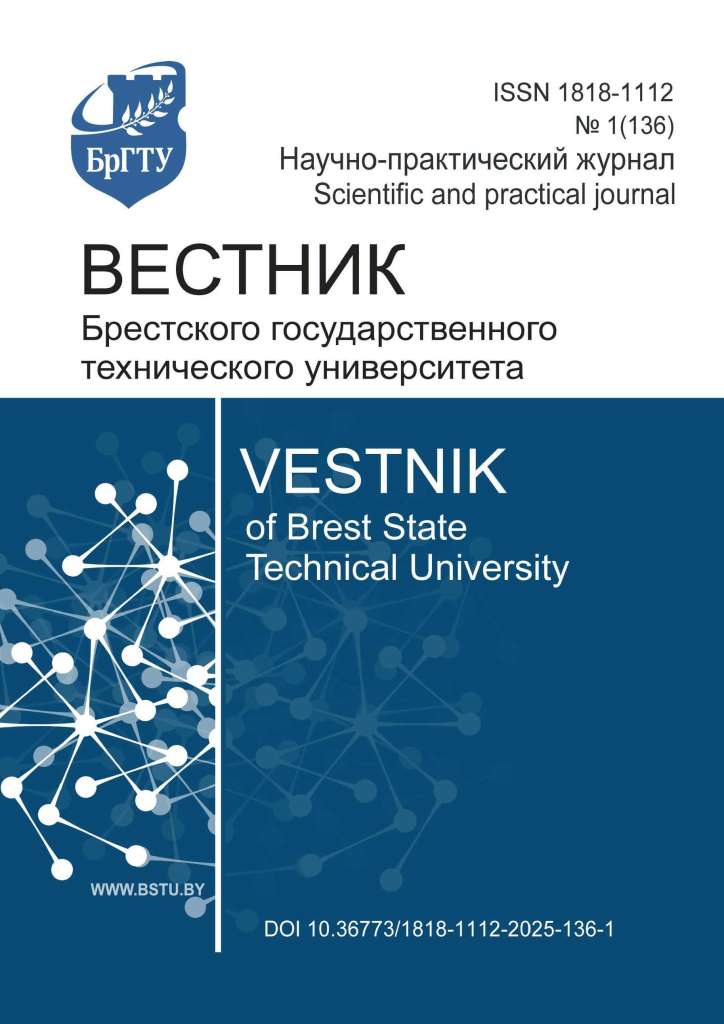SIMULATION AND EXPERIMENTAL STUDY OF THE ELECTRON BEAM HARDENING OF STEELS
DOI:
https://doi.org/10.36773/1818-1112-2025-136-1-96-102Keywords:
surface engineering, electron beam heating, hardening, simulationAbstract
The use of electron beam treatment of materials makes it possible to implement physical-chemical, metallurgical, thermal, radiation, biological and other types of processes in a wide range of applications - from food and medical products sterilization to remelting metal ingots.
When processing the surface of steel products by heating with a flow of electrons in a time interval of less than 10 s, a mode of electron beam hardening (EBH) of local part zones can be organized. Unlike the method of volume heat treatment, EBH does not require a hardening medium, cooling of the heated layer of material occurs by heat transfer into the unheated product core. Due to the high heating and cooling rates, the structure of the steel after EBH is refined, and the hardness of the hardened structures is higher compared to those obtained by bulk hardening.
The modes of EBH implementation are determined for the applied grade of material, a specific product, the required configuration of the hardened zone, the location of the part on its surface and for the existing type of electron beam equipment. Rational values of EBH parameters can be selected using thermal process modeling. Simulation and experimental study of electron beam treatment allows minimizing energy input during steel hardening processes in which the amount of heat transferred must be limited.
The characteristics of steel hardened by EBH depend on the preliminary structure preparation and the thermal material properties. For the widely used 40Kh steel, the best combination of dispersion and thermal conductivity is the troostosorbite structure obtained after preliminary hardening from 850 °C and tempering at 500 °C.
This mode of volume heat treatment with subsequent surface EBH makes it possible to obtain working areas with high material hardness on a product with a plastic core. In general, this combination of properties leads to an improvement in the operational products characteristics.
References
Рыкалин, Н. Н. Основы электронно-лучевой обработки материалов / Н. Н. Рыкалин. – М. : Машиностроение, 1978. – 239 с.
Schiller, S. Electron beam technology / S. Schiller, U. Heisig, S. Panzer. – New York : John Wiley & Sons, 1982. – 508 p.
Friedel, K. Oddzialywanie wiązki elektronowej na cialo stale u warunkach glebokiej penetracji / K. Friedel // Prac. Nauk. Inst. Technol. Elektron. PWR. – 1983. – № 27. – 67 s.
Электронно-лучевая сварка / O. K. Назаренко, А. А. Кайдалов, С. Н. Ковбасенко [и др.] ; под ред. Б. Е. Патона. – Киев : Навукова думка, 1987. – 256 с.
Шипко, А. А. Упрочнение сталей и сплавов с использованием электронно-лучевого нагрева / А. А. Шипко, И. Л. Поболь, И. Г. Урбан. – Минск : Наука и техника, 1995. – 280 с.
Электронно-лучевая обработка материалов / В. Н. Алехнович, А. В. Алифанов, А. И. Гордиенко, И. Л. Поболь. – Минск : Белорусская наука, 2006. – 319 с.
Патон, Б. Е. Электронно-лучевая плавка тугоплавких и высокореакционных металлов / Б. Е. Патон, Н. П. Тригуб, С. В. Ахонин. – Киев : Навукова думка, 2008. – 312 с.
Zenker, R. Modern thermal electron beam processes - research results and industrial application / R. Zenker // Metallurgia Italiana. – 2009. – Vol. 101. – P. 1–8.
Dutta, B. The аdditive manufacturing (AM) of titanium alloys / B. Dutta, F. H. Froes // Metal Powder Report. – 2017. – Vol. 72. – P. 96–106.
Prospects of application of gas-discharge electron beam guns in additive manufacturing / D. Kovalchuk, V. Melnyk, I. Melnyk, B. Tugai // Electrotechnica&Electronica. – 2016. – № 5–6. – Р. 36–42.
Получение металлических изделий с применением электронно-лучевых аддитивных технологий / В. Г. Залесский, И. Л. Поболь, А. А. Бакиновский, А. Д. Губко // Вес. Нац. акад. навук Беларусі. Сер. фіз.-тэхн. навук. – 2018. – Т. 63, № 2. – С. 169–180.
A substrate material and thickness influence on the 3D-printing of Ti-6Al-4V components via wire-feed electron beam additive manufacturing / K. N. Kalashnikov, A. V. Chumaevskii, T. A. Kalashnikova, E. A. Kolubaev // Journal of Materials Research and Technology. – 2022. – Vol. 16, Iss. 1. – P. 840–852.
Аддитивные технологии в производстве металлических конструкций: учебник / А. В. Щербаков, Д. А. Гапонова, А. П. Слива [и др.] ; ред. А. Г. Григорьянц, В. К. Драгунов ; Национальный исследовательский ун-т "МЭИ". – М. : Изд-во МЭИ, 2022. – 675 с.
Ерохин, А. А. Об эффективном коэффициенте полезного действия процесса проплавления электронным лучом / А. А. Ерохин, В. Ф. Резниченко, А. Ф. Худышев // Физика и химия обработки материалов. – 1970. – № 3. – С. 131–133.
Зуев, И. В. Эффективный к.п.д. электронно-лучевого нагрева / И. В. Зуев, Н. Н. Рыкалин, А. А. Углов // Физика и химия обработки материалов. – 1976. – № 1. – С. 22–25.
Наnsоn, Р. Computer controlled electron beam treating effective for hardening steel / Р. Наnsоn // Ind. Неаt. – 1984. – Vol. 51, Iss. 1. – Р. 17–20.
Ваrtеl, R. Oberflächenschmelzbehandeln mit Elektronenstrahlen / R. Ваrtеl, М. Мullеr // Sсhwеisstесhnik. – 1986. – Вd. 36, N 11. – S. 489–491.
Stähli, G. Тrаitemеnt thermiquе rapide / G. Stähli // Тrаitemеnt Тhermiquе. – 1986. – Vol. 199. – Р. 43–53.
Bashenko, V. The electron beam alloy hardening factors / V. Bashenko, M. Radchenko // 4-ème Соllоq. int. sоudаgе еt fusiоn fаisсеаu еlесtrоns еt lаsеr. Саnnеs. – 1988. – P. 515–522.
Физические основы электротермического упрочнения стали / В. Н. Гриднев, Ю. Я. Мешков, С. П. Ошкадеров, Н. Ф. Черненко. – Киев : Навукова думка, 1973. – 336 c.
Сорокин, В. Г. Марочник сталей и сплавов / В. Г. Сорокин, А. В. Волосникова, С. А. Вяткин. – М. : Машиностроение, 1989. – 640 с.
Сталь 40Х: характеристики. – URL: https://atissteel.ru/stal-40h-harakteristiki (дата обращения: 20.02.2025).
Лившиц, Б. Г. Физические свойства металлов и сплавов / Б. Г. Лившиц, В. С. Крапошин, Я. Л. Линецкий. – М. : Металлургия, 1980. – 295 с.
Downloads
Published
How to Cite
Issue
Section
License

This work is licensed under a Creative Commons Attribution-NonCommercial 4.0 International License.
The work is provided under the terms of Creative Commons public license Attribution-NonCommercial 4.0 International (CC BY-NC 4.0). This license allows an unlimited number of persons to reproduce and share the Licensed Material in all media and formats. Any use of the Licensed Material shall contain an identification of its Creator(s) and must be for non-commercial purposes only. Users may not prevent other individuals from taking any actions allowed by the license.










